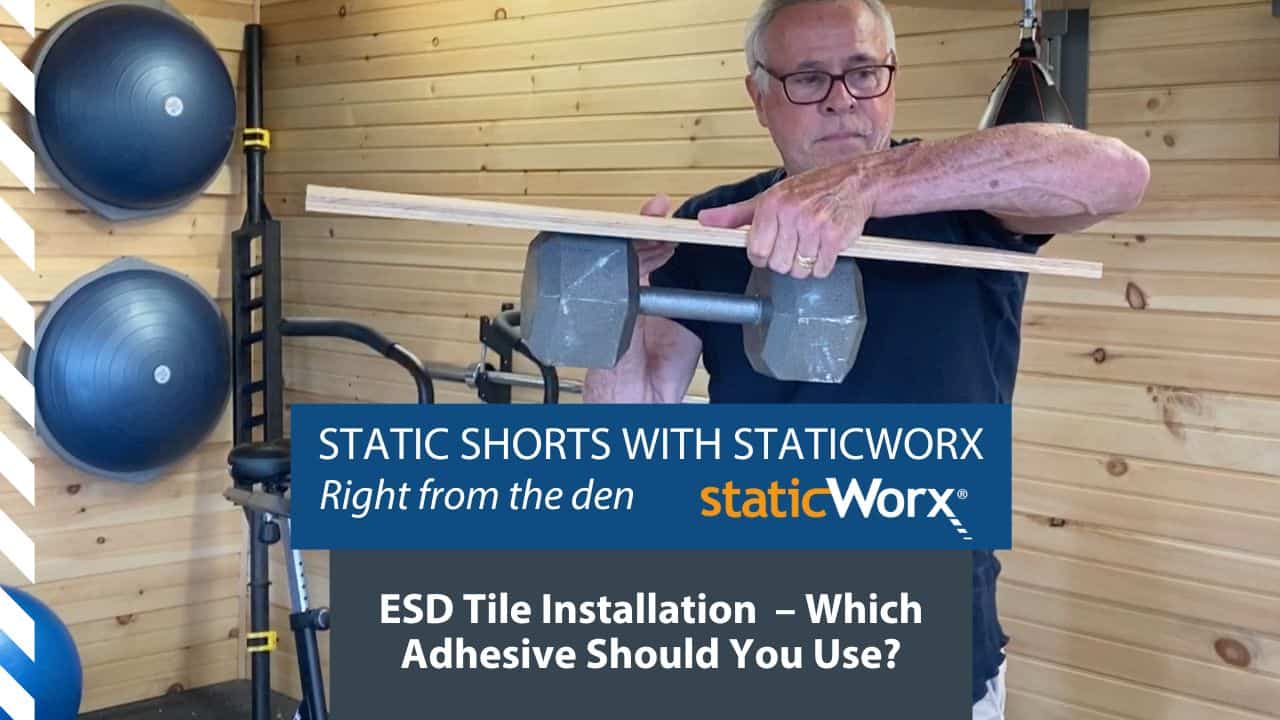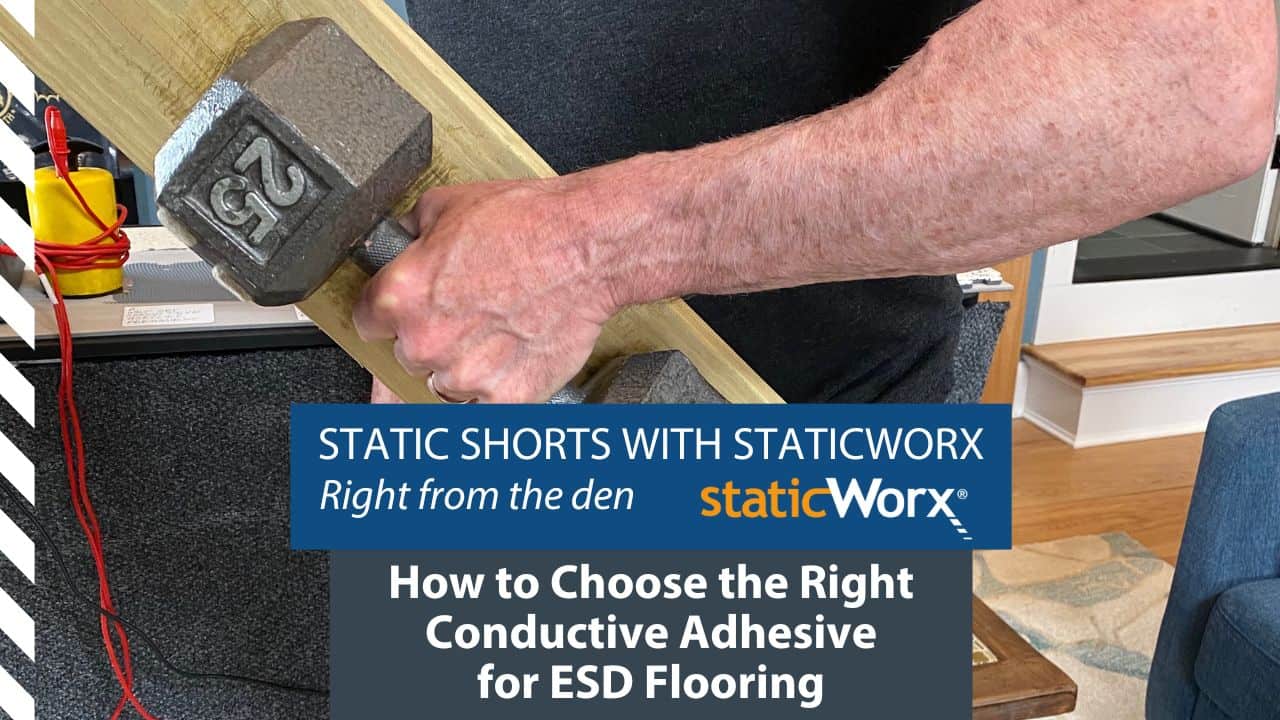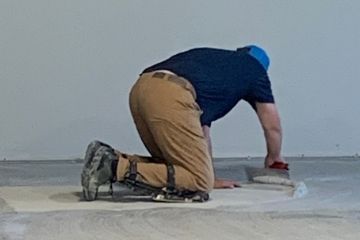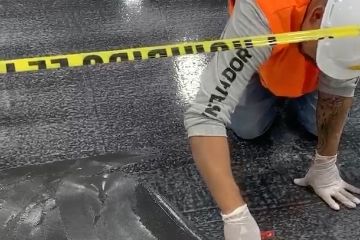This video explains why it’s crucial to think of ESD flooring and ESD chairs as a system, not standalone products.


ESD Tile Installation - Which Adhesive Should I Use?
Static Shorts with StaticWorx: Right from the den

So all I'm going to do in this video is I'm going to pick up these pieces of wood and I'm going to tip them upside down and we'll see if the adhesive actually holds the dumbbell.
Hi, I’m Dave Long from StaticWorx. We launched a video on YouTube recently comparing different types of conductive adhesive, and I’ve gotten a few questions. One of the biggest questions I got was, “Can you show me the bond strength differences between pressure-sensitive adhesives?” It’s a big deal to a lot of people because pressure-sensitive adhesives make jobs a lot easier. They’re not messy. They don’t ooze up through tiles when you roll the tiles.
So what I’ve done to demonstrate this is I’ve taken three dumbbells. I took a 15 pounder, which I’ve attached to this piece of wood with conductive pressure-sensitive releasable adhesive. I took a 25-pound dumbbell. I’ve attached it to this piece of wood with StatBond permanent conductive adhesive. And I went for broke, I decided to mount a 40-pound dumbbell to this one with StatBond permanent adhesive.
So all I’m going to do in this video is I’m going to pick up these pieces of wood and I’m going to tip them upside down and we’ll see if the adhesive actually holds the dumbbell.
So I’m going to start with the 15 pounder that’s held with the releasable adhesive. Did exactly what it’s supposed to do.
Now let’s take the 25 pound dumbbell. No problem.
Let’s take the 40 pounder. No problem.
That’s what I’m talking about when I talk about bond strength. By the way, these are all steel dumbbells. So it doesn’t really matter what your substrate is, it can be VCT, old epoxy, concrete, or metal, this adhesive will bond all of those materials.
Thanks for watching this. Please sign up for our YouTube channel. We have over 20 videos, I think you’ll find them all very interesting. Thanks again.
Hi, I’m Dave Long from StaticWorx. We launched a video on YouTube recently comparing different types of conductive adhesive, and I’ve gotten a few questions. One of the biggest questions I got was, “Can you show me the bond strength differences between pressure-sensitive adhesives?” It’s a big deal to a lot of people because pressure-sensitive adhesives make jobs a lot easier. They’re not messy. They don’t ooze up through tiles when you roll the tiles.
So what I’ve done to demonstrate this is I’ve taken three dumbbells. I took a 15 pounder, which I’ve attached to this piece of wood with conductive pressure-sensitive releasable adhesive. I took a 25-pound dumbbell. I’ve attached it to this piece of wood with StatBond permanent conductive adhesive. And I went for broke, I decided to mount a 40-pound dumbbell to this one with StatBond permanent adhesive.
So all I’m going to do in this video is I’m going to pick up these pieces of wood and I’m going to tip them upside down and we’ll see if the adhesive actually holds the dumbbell.
So I’m going to start with the 15 pounder that’s held with the releasable adhesive. Did exactly what it’s supposed to do.
Now let’s take the 25 pound dumbbell. No problem.
Let’s take the 40 pounder. No problem.
That’s what I’m talking about when I talk about bond strength. By the way, these are all steel dumbbells. So it doesn’t really matter what your substrate is, it can be VCT, old epoxy, concrete, or metal, this adhesive will bond all of those materials.
Thanks for watching this. Please sign up for our YouTube channel. We have over 20 videos, I think you’ll find them all very interesting. Thanks again.
Get in Touch
The form below will help us better understand your needs and get you as quickly as possible to the right person. We look forward to helping you solve your static problem!
You can expect a response within 24 hours. For faster service, please give us a call: 617-923-2000
"*" indicates required fields
Visit our privacy policy to find out how we process data.
More Static Shorts Episodes
Installing ShadowFX ESD carpet tile over raised access panels is easy, using conductive releasable adhesive and a 1/16” trowel.
In this video, we test the electrical resistance of conductive vinyl and conductive rubber.
StaticWorx offers a GroundSafe™ certification program that involves testing the floor for resistance (ohms) before and after installation, then certifying compliance.
A lot of people want to know what's the difference between a regular floor and an ESD floor. In this video, Kimberly Petraccaro explains.
In this short video, Kimberly Petraccaro demonstrates how quick and easy it is to ground your ESD Floor.
In this short video Dave Long, President of StaticWorx, Inc., demos how quick and easy it is to work with GroundLock interlocking ESD tile.
Conductive adhesive is often the most important part of your project instead of what you're usually thinking about, which is the floor.
When choosing flooring, remember: Conductivity means something. Static generation/discharge tests mean something. "Low kV" means nothing.
Today in the den, Dave's talking about meeting govt standards for FAA 019f & other facilties, including flight towers & 9-1-1 call centers.
Dave discusses the difference between the static-dissipative and charge-generation properties of regular rubber flooring and conductive rubber flooring.
Today, Dave’s talking about conductivity and testing the electrical resistance of regular, static-dissipative, and highly conductive carpet.
In this video, Dave Long - President and CEO of Staticworx - busts the Low kV Carpet Myth wide open: low kV carpet is NOT static free.
Learning Center Articles
- ESD Basics
- Installation & Maintenance
- Selecting & Specifying an ESD Floor
- Technical Information
- 7 Common Mistakes Selecting an ESD floor
- A Guide to ESD Flooring Selection
- Avoid Costly Failures: What You Need to Know When Specifying ESD Flooring
- Choosing ESD Flooring for:
- ESD Footwear: What Is It and When Is It Necessary?
- ESD Footwear for Electronics Manufacturing and Handling Applications
- Facility Managers’ Guide to Selecting ESD Flooring
- The Need for Due Diligence in Specifying Static-Free Flooring
- Standard of Care for Specifying Floors in Mission-Critical Spaces
- Understanding the Hidden Costs of ESD Flooring

StaticWorx high-performance static-control floors protect electronic components, explosives, and high-speed computers from damage caused by static electricity. ESD flooring is part of a system. Choices should always be based on objective, researched evidence. When you partner with us, we look at all possible items that may need to integrate with the floor, and, focusing on your goals and objectives, help you find the right floor for your application.



























